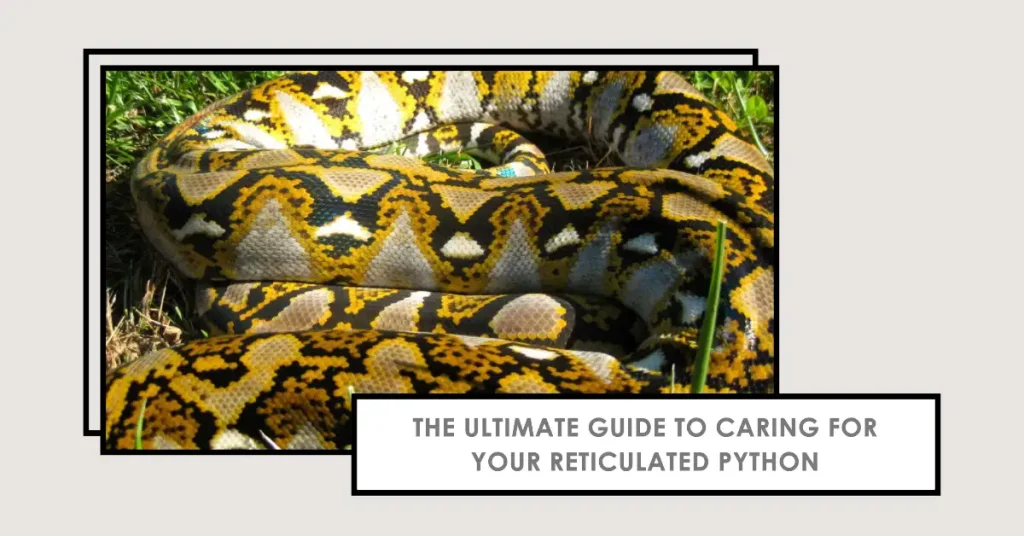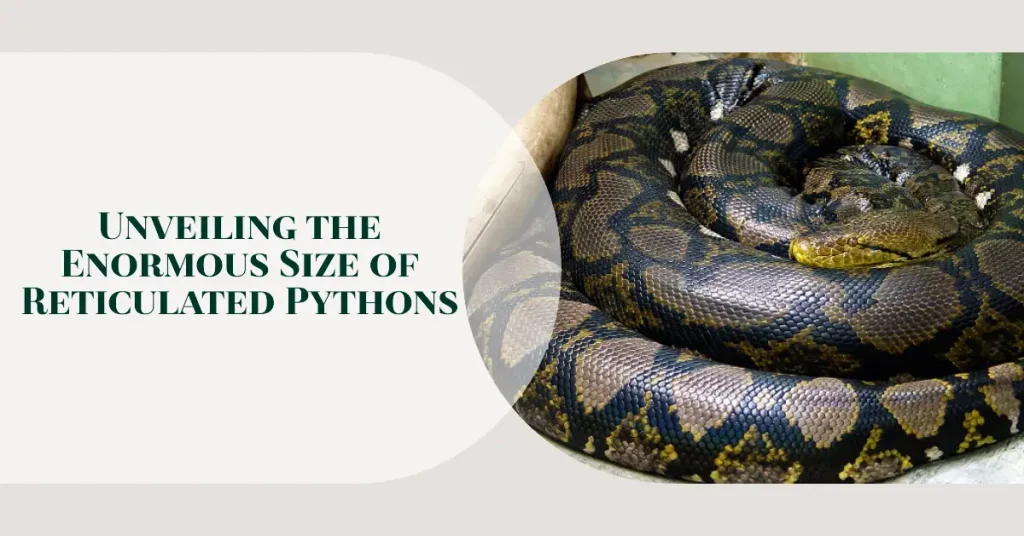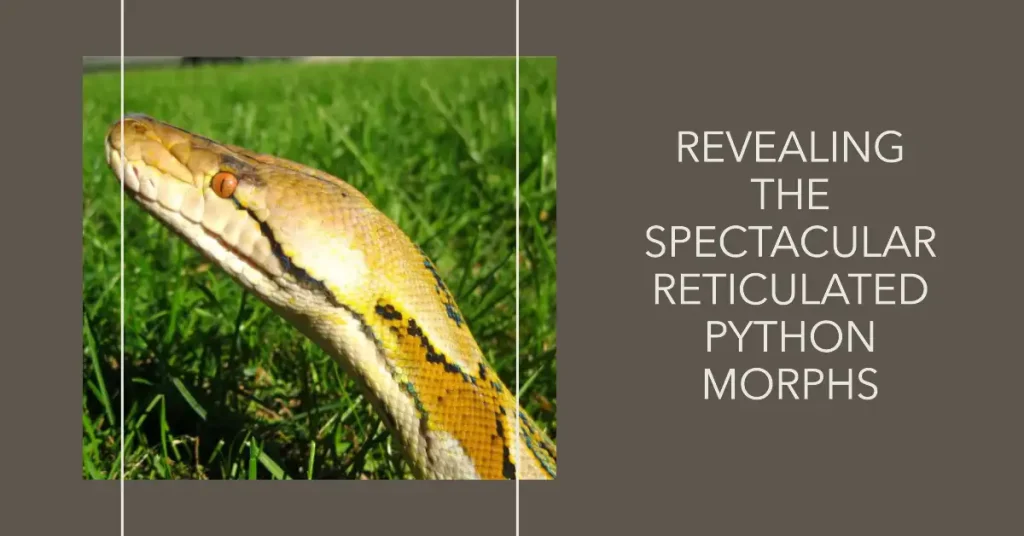I have extensive knowledge about reticulated python care. Reticulated pythons are beautiful creatures that require proper care to ensure their health and happiness. In this article, I will provide expert tips and information on all aspects of reticulated python care.
Key Takeaways:
- Proper reticulated python care is crucial for the health and well-being of your pet.
- Understanding their natural behavior and habitat is essential for creating an optimal habitat.
- Feeding and handling techniques should be carefully considered to prevent potential health issues and ensure proper socialization.
- Maintaining a stress-free environment is important for your pet’s overall health and happiness.
Understanding Reticulated Pythons
Before diving into the specifics of reticulated python care, it’s important to have a basic understanding of these fascinating snakes.
Reticulated pythons are the world’s longest snakes, with some individuals reaching lengths of over 30 feet. They are native to Southeast Asia, where they inhabit a range of environments from rainforests to grasslands.
Despite their massive size, reticulated pythons are generally docile and make for great pets with proper care. However, they do require a significant amount of space and specialized care.
Behavior and Temperament
Reticulated pythons are primarily solitary animals, only coming together to mate. They are also nocturnal, meaning they are most active at night. In captivity, they can become accustomed to being handled, but it’s important to remember that they are still powerful predators and care should be taken when interacting with them.
It’s also important to note that reticulated pythons have a strong feeding response and may mistake a hand or other object for prey. It’s crucial to always supervise interactions with these snakes and never leave them unattended with small children or other pets.
Natural Habitat
Reticulated pythons are native to Southeast Asia, where they are found in a variety of environments from rainforests to grasslands. They are excellent swimmers and are often found near bodies of water.
In captivity, it’s important to replicate their natural habitat as much as possible. This includes providing a large, secure enclosure with a substrate that mimics the forest floor, such as cypress mulch or coconut coir.
Additionally, reticulated pythons require a basking spot with a temperature of around 90-95 degrees Fahrenheit and a cooler area of around 78-80 degrees Fahrenheit. Humidity should also be kept high, around 50-60%, to prevent respiratory issues.
Creating the Ideal Reticulated Python Habitat
As a responsible reticulated python owner, it’s essential to provide your pet snake with a comfortable and secure habitat that mimics their natural environment. Creating the proper habitat involves several essential elements, including:
Enclosure Size
Reticulated pythons are large snakes and require plenty of space to move around comfortably. The minimum enclosure size for an adult reticulated python should be at least 6 feet long, 3 feet wide, and 2 feet tall. It’s crucial to remember that larger enclosures are always better, as they provide your snake with more space to explore and exercise.
Substrate
The substrate is the material used to line the enclosure’s bottom and should replicate the natural habitat of reticulated pythons. Suitable substrates include aspen shavings, cypress mulch, or coconut fiber. Avoid using substrates that can cause impaction or respiratory issues, such as sand or cedar shavings.
Temperature and Humidity
Reticulated pythons require specific temperature and humidity levels to thrive. The enclosure’s temperature should range between 80-85°F on the cool side and 88-92°F on the warm side. The humidity level should be maintained between 50-60% to prevent respiratory issues, skin problems, and dehydration. Installing a hygrometer and thermometer in the enclosure can help you monitor and maintain these levels.
Lighting
Reticulated pythons require a day/night cycle to regulate their behavior and maintain their natural rhythms. Providing 12-14 hours of light per day and 10-12 hours of darkness can help simulate their natural habitat. Consider installing a timer for the lights to ensure consistency and avoid disturbing your snake’s sleep cycle.
Hiding Spots
Reticulated pythons are ambush predators and require ample hiding spots to feel secure and reduce stress. Providing a minimum of two hiding spots, one on the cool side and one on the warm side, is essential. Hiding spots can include commercial hides, cardboard boxes, or even towel rolls.
By providing a proper habitat, you can ensure your reticulated python stays healthy, happy, and comfortable.
Feeding Reticulated Pythons: A Nutritional Guide
As carnivorous reptiles, reticulated pythons require a well-balanced diet to maintain their health and growth. In the wild, they feed on a variety of prey such as rodents, birds, and other small mammals. In captivity, it is important to replicate their natural diet as much as possible.
Types of Food
Feeding reticulated pythons can be challenging because of their size and diet requirements. They need to be fed appropriately sized prey for their age and size. Hatchlings can be fed appropriately sized mice, while adult pythons will require larger prey such as rabbits or even pigs.
I recommend feeding frozen-thawed prey to reduce the risk of injury to both the snake and the feeder. It is also important to vary their diet to ensure they receive all necessary nutrients. Frozen rodents can be supplemented with quail, chicks, and other small mammals.
Feeding Frequency
Young pythons should be fed every 5-7 days, while adults can be fed every 7-14 days. It is essential to monitor their weight closely and adjust their feeding schedule accordingly. Overfeeding can lead to obesity and other related health problems.
Prey Size
The size of the prey should match the size and age of the snake. The prey should be no larger than the widest part of the python’s body to prevent choking or regurgitation. Hatchlings can be fed appropriately sized rodents, while adults may require larger prey such as rabbits.
Health Issues Related to Feeding
Constipation is a common issue for reticulated pythons, which can often be caused by poor nutrition or dehydration. Make sure to provide your python with fresh water at all times and monitor their bowel movements. If you notice any irregularities, consult with a veterinarian.
Just like humans, pythons can also be susceptible to obesity-related health problems. Avoid overfeeding your snake and make sure to monitor their weight closely. Other issues, such as regurgitation, can also be caused by overfeeding or feeding prey that is too large.
Handling Reticulated Pythons with Confidence
Handling reticulated pythons can be daunting, especially for novice snake owners. However, with patience and practice, handling can become a routine part of caring for your pet snake. Here are some tips to help you handle your reticulated python with confidence.
Proper Technique
When handling a reticulated python, it is important to support their entire body to prevent injury and stress. Never lift a snake by their neck or tail, as this can cause serious harm. Instead, use both hands to scoop up the snake from underneath their body. Once you have a firm grip, lift them slowly and support them evenly, keeping their body close to your own.
Potential Risks
While reticulated pythons can be handled safely, it is important to be aware of the potential risks involved. These snakes can inflict serious bites and may become aggressive if they feel threatened or stressed. Always approach your snake slowly and calmly, avoiding sudden movements or loud noises that could startle them. In addition, never handle your snake alone, as you may need assistance in case of an emergency.
Regular Handling
Handling your reticulated python on a regular basis is important for their socialization and overall well-being. Make sure to start handling your snake slowly and for short periods of time, gradually increasing the duration as they become more comfortable. It is also a good idea to handle your snake at the same time each day to establish a routine.
Handling reticulated pythons can be a rewarding experience for both you and your pet. By following proper techniques, being aware of potential risks, and regularly handling your snake, you can create a confident and healthy bond with your reticulated python.
The Importance of Maintaining Optimal Temperature
Maintaining an appropriate temperature range is crucial for the health and well-being of your reticulated python. As a cold-blooded species, they rely on external heat sources to regulate their body temperature. Failure to provide adequate heating can lead to a range of health problems, including respiratory infections and digestive issues.
The recommended temperature range for reticulated pythons is between 85 and 90 degrees Fahrenheit on the warm side of the enclosure and 75 to 80 degrees Fahrenheit on the cool side. It’s important to monitor the temperature regularly using a thermometer to ensure it remains within this range.
Heating can be provided using a range of methods, including under-tank heating pads, ceramic heat emitters, and basking lamps. It’s essential to use a thermostat with any heating source to prevent overheating and provide a consistent temperature.
It’s important to note that extreme temperature fluctuations can be harmful to your pet snake. Avoid exposing them to drafts, direct sunlight, or cold temperatures that may drop below 75 degrees Fahrenheit.
By maintaining an appropriate temperature range, you can ensure that your reticulated python stays healthy and happy, reducing the risk of health problems and ensuring a long and fulfilling life.
Promoting Reticulated Python Health: Common Issues and Prevention
As a responsible reticulated python owner, it’s crucial to know the signs of illness and how to prevent common health issues. Even with the best care, snakes can still become sick, so it’s essential to make sure your snake receives prompt veterinary attention if you notice anything concerning.
Signs of illness:
| Symptom | Possible Health Issue |
|---|---|
| Lack of appetite | Digestive issues or infection |
| Weight loss | Malnutrition or parasitic infection |
| Lethargy | Bacterial or viral infection |
| Respiratory issues | Respiratory infection |
| Abnormal feces | Parasites or digestive issues |
Preventing common health issues:
- Maintain proper hygiene: Keep the enclosure clean and disinfected regularly to prevent bacterial infections.
- Monitor temperature and humidity: Make sure the enclosure is within the recommended temperature range and humidity level to prevent respiratory infections.
- Feed a balanced diet: Provide a varied diet that includes the appropriate size prey and supplements. Avoid feeding live prey to prevent potential injuries to your snake.
- Avoid stress: Minimize disturbances and provide a calm and quiet environment to prevent stress-related health issues.
“Remember, prevention is always better than cure. Regular check-ups and prompt veterinary care can help keep your reticulated python healthy and happy.”
Breeding Reticulated Pythons: Considerations and Tips
Breeding reticulated pythons can be a rewarding experience for pet owners with the right preparations and care. However, it is important to note that breeding should only be attempted by experienced snake owners, as it can come with risks and challenges.
Before attempting to breed reticulated pythons, it is essential to ensure that the snakes are healthy, sexually mature, and in good condition. This process typically involves a period of conditioning, during which the snakes are provided with appropriate temperature, humidity, and feeding conditions to prepare them for breeding.
Selecting Breeding Pairs
When it comes to selecting breeding pairs, it is important to choose individuals that are healthy, of an appropriate age and size, and genetically diverse. Inbreeding can increase the risk of genetic disorders, so it is best to avoid breeding siblings or closely related snakes.
Male reticulated pythons typically reach sexual maturity around 2-3 years of age, while females may take longer to mature and may not be ready to breed until they are 4-5 years old. It is also important to ensure that the female is in good physical condition and is not too thin or overweight to carry a clutch of eggs.
Breeding Process
Once the snakes are successfully paired, they may begin the breeding process. During this time, the male will typically display behaviors such as circling and tapping the female, as well as emitting pheromones to signal his readiness to mate.
After successful mating, the female will typically enter a post ovulatory shed, during which she will shed her skin as her body prepares to develop and lay eggs. It is essential to provide her with an appropriate nesting area and substrate during this time, such as a box filled with damp sphagnum moss.
Once the eggs are laid, they should be carefully removed from the nest and placed in an appropriate incubator. Reticulated python eggs typically take around 60-80 days to hatch, and it is important to monitor the temperature and humidity levels in the incubator to ensure optimal conditions for the embryos.
Caring for Gravid Females and Hatchlings
During the breeding process, it is essential to provide ample food and water to the gravid female to ensure that she maintains her health and energy levels. It is also important to monitor her behavior and health closely, as complications such as egg binding can occur.
Once the eggs hatch, the hatchlings will require appropriate care and feeding to ensure their health and development. This typically involves providing them with a suitable enclosure, temperature, and humidity conditions, as well as an appropriate diet consisting of appropriately sized prey items.
With proper care and attention, breeding reticulated pythons can be a rewarding experience for pet owners. However, it is important to approach breeding with caution and only attempt it if you have the experience and knowledge necessary to ensure a successful outcome.
Ensuring a Stress-Free Environment for Your Pet Python
As a reticulated python owner, it’s important to create a stress-free environment for your pet. These snakes are sensitive to their surroundings and can become easily stressed if they feel threatened or uncomfortable. Here are some tips to help you promote a calm and peaceful space for your reticulated python:
- Provide adequate space: Ensure that your reticulated python has enough space to move around comfortably without feeling cramped. A spacious enclosure can help reduce stress levels and promote healthy behavior.
- Minimize disturbances: Reticulated pythons are sensitive to noise and movement, so it’s essential to keep their environment quiet and calm. Avoid making sudden movements or loud noises that may startle your python.
- Handle with care: When handling your reticulated python, it’s important to do so with care and gentleness. Avoid rough handling or sudden movements that may cause your python to feel threatened or stressed.
- Create hiding spaces: Reticulated pythons are naturally shy and may feel more comfortable when they have a designated hiding spot. Providing a safe space for your python to retreat to can help reduce stress levels and promote healthy behavior.
By following these simple tips, you can help ensure a stress-free environment for your reticulated python. Remember, a calm and peaceful space can promote healthy behavior and help your pet thrive.
Conclusion
As you can see, proper reticulated python care is essential for a healthy and happy pet snake. From understanding their behavior to creating an ideal habitat and providing proper nutrition, there are many factors to consider when caring for these fascinating creatures.
Regular handling and veterinary check-ups, as well as maintaining optimal temperature levels and a stress-free environment, are all crucial components of responsible reticulated python ownership. By following the tips and guidelines provided in this article, you can ensure that your pet snake thrives and lives a long and fulfilling life.
Remember, owning a reticulated python is a significant responsibility, but with proper care and attention, it can be a rewarding and enriching experience. Always be mindful of your snake’s needs and stay informed about the latest practices and trends in reticulated python care.
FAQ
Q: What do reticulated pythons eat?
A: Reticulated pythons are carnivores and primarily eat small to medium-sized mammals, such as rats and rabbits.
Q: How often should I feed my reticulated python?
A: It is recommended to feed adult reticulated pythons once every 1-2 weeks, while younger snakes may require more frequent feedings.
Q: What size prey should I offer my reticulated python?
A: Prey items should be appropriately sized to match the girth of the snake. Generally, the prey should be around 1.5 times the width of the snake’s body.
Q: How important is proper temperature for reticulated pythons?
A: Maintaining the correct temperature range is crucial for the health and well-being of reticulated pythons. Incorrect temperatures can lead to digestive issues and a weakened immune system.
Q: What are common health issues that can affect reticulated pythons?
A: Common health issues in reticulated pythons include respiratory infections, parasites, and mouth rot. Regular veterinary check-ups and proper care can help prevent these issues.
Q: How do I create a stress-free environment for my reticulated python?
A: Minimizing disturbances, handling with care, and providing a calm and quiet space are important for reducing stress in reticulated pythons.
Featured image: Kyle Zimmerman, CC BY-SA 4.0, via Wikimedia Commons


